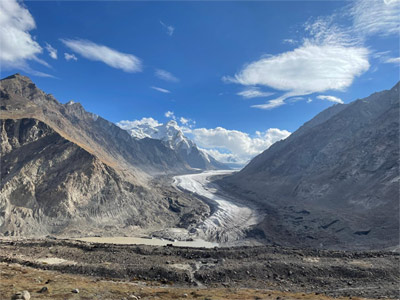
Sightseeing in Zanskar Valley
Zanskar Valley is one of the most stunning, remote regions in the Indian Himalayas, offering a rich mix of natural beauty, ancient monasteries, and a unique Tibetan culture. Here’s a guide to some of the most remarkable sightseeing spots and experiences in Zanskar Valley:
Phugtal Monastery
Location: Perched on a cliffside along the Lungnak River.Significance: One of the most visually striking and isolated monasteries in the world, Phugtal Monastery is over 800 years old and is a spiritual hub for Tibetan Buddhists. The monastery is carved into a cliff face and is accessible by a challenging trek from Padum.
Highlights: The monastery is famous for its unique architecture, meditation caves, and beautiful frescoes. The serenity of the surrounding area and the views from the monastery are incredible, making it a must-visit.
Zangla Palace
Location: Near the village of Zangla, about 30 km from Padum.Significance: Zangla was once the capital of the Zanskar Kingdom and home to the royal family. The Zangla Palace offers an intriguing insight into the region’s history and culture.
Highlights: The ruins of the palace, combined with the surrounding landscape of Zanskar, create a majestic setting. The village itself is picturesque and offers a glimpse into traditional Zanskari life.
Stongdey Monastery
Location: Around 18 km from Padum, in the village of Stongdey.Significance: Stongdey is one of the largest and most important monasteries in Zanskar, home to several monks and featuring a rich collection of Tibetan Buddhist art.
Highlights: The monastery is situated on a high hill, offering panoramic views of the valley. It’s a peaceful and less-visited spot, allowing for a more intimate experience with the monks and the culture. You can also witness prayers and rituals here.
Karsha Monastery
Location: Near the village of Karsha, around 10 km from Padum.Significance: The largest monastery in Zanskar, Karsha dates back to the 11th century and is home to a large community of monks.
Highlights: The monastery has a rich collection of murals, scriptures, and thangkas (Tibetan scroll paintings). It offers beautiful views of the Zanskar Valley and the surrounding mountain peaks.
Rangdum Monastery
Location: Around 130 km from Padum, on the road connecting Zanskar to Suru Valley.Significance: Rangdum Monastery is situated at a high altitude and is a remote but stunning place for spiritual retreat.
Highlights: The monastery is surrounded by towering peaks and offers a serene atmosphere. It’s often less crowded than other monasteries, making it a peaceful place to visit.
Zanskar’s Villages
Famous Villages to Visit:Padum: The administrative capital of Zanskar, Padum is a central base for travelers and offers insight into Zanskari life.
Purni: A small, picturesque village at the base of the Phugtal Monastery trek.
Rinam: A quiet village with traditional architecture and access to nearby trekking routes.
Highlights: Zanskar's villages are some of the most remote in India, and visiting them gives you a chance to experience local life in its most unspoiled form. You can interact with local families, see traditional farming practices, and get a taste of Zanskari hospitality.
Trekking and Outdoor Adventures
Zanskar offers some of the best trekking routes in Ladakh and India:Chadar Trek: A winter trek along the frozen Zanskar River, famous for its icy and surreal landscape.
Phugtal Monastery Trek: A multi-day trek through valleys and gorges to one of the most beautiful and remote monasteries.
Markha Valley Trek: While not strictly within Zanskar, it connects the Zanskar region to the larger Ladakh area and offers breathtaking views.
Best Time for Sightseeing:
Summer (June to September) is the best time to visit Zanskar, as most of the trekking routes are accessible, and the weather is relatively pleasant.Autumn (October) offers clear skies and fewer tourists, making it an ideal time for a quieter visit.
Winter (December to February) is extremely cold and not recommended for general sightseeing or trekking due to heavy snow and freezing temperatures.
Cultural Experiences:
Festivals: Zanskar is home to various Buddhist festivals, such as the Ladakhi New Year (Losar) and Monastery Festivals, which feature traditional dances, music, and spiritual rituals.Traditional Crafts: The local people are skilled in traditional crafts such as thangka painting, wood carving, and woolen weaving, which you can see in local markets or monasteries.
Zanskar Valley is a treasure trove of experiences, from its peaceful monasteries and remote villages to its dramatic landscapes and adventurous treks. Whether you’re looking for spiritual exploration, cultural immersion, or outdoor adventure, the valley has something unique to offer.


